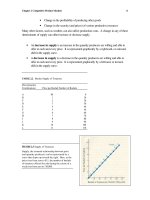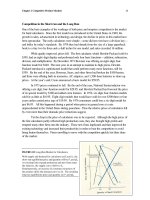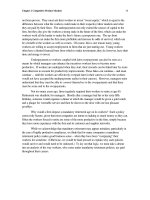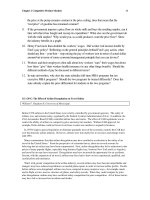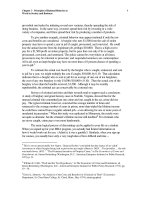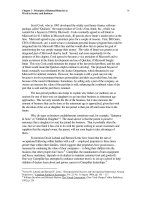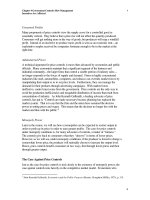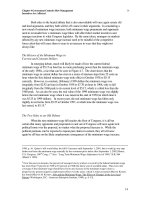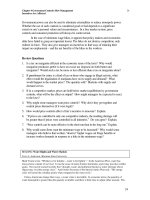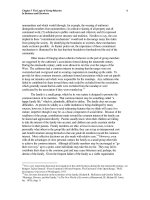Tài liệu Microeconomics for MBAs 7 pptx
Bạn đang xem bản rút gọn của tài liệu. Xem và tải ngay bản đầy đủ của tài liệu tại đây (190.01 KB, 10 trang )
Chapter 2 Competitive Product Markets
20
Competition in the Short run and the Long Run
One of the best examples of the workings of both price and nonprice competition is the market
for hand calculators. Since the first model was introduced in the United States in 1969, the
growth in sales, advancement in technology and design, the decline in prices in this market have
been spectacular. The early calculators were simple—some did not even have a division key—
and bulky by today’s standards. By 1976 they had shrunk from the size of a large paperback
book to a tiny two by three-and-a-half inches for one model, and sales exceeded 16 million.
While quality improved, prices fell. The first calculator, which Hewlett-Packard sold for
$395, had an eight-digit display and performed only four basic functions—addition, subtraction,
division, and multiplication. By December 1971 Bowmar was offering an eight-digit, four-
function model for $240. The next year, in an attempt to maintain its high prices, Hewlett-
Packard introduced a sophisticated model that could perform many more functions, still for
$395. By the end of the year, Bowmar, Sears, and other firms had broken the $100 barrier,
and firms were offering built-in memories, AC adapters, and 1,500-hour batteries to shore up
prices. At the year’s end, Casio announced a basic model for $59.95.
In 1973 prices continued to fall. By the end of the year, National Semiconductor was
offering a six-digit, four-function model for $29.95, and Hewlett-Packard had lowered the price
of its special model by $100 and added extra features. In 1974, six-digit, four-function models
sold for as little as $16.95. Eight-digit models that would have sold for over $300 three or four
years earlier carried price tags of $19.95. By 1976 consumers could buy a six-digit model for
just $6.95. All this happened during a period when prices in general rose at a rate
unprecedented in the United States during peacetime. Thus the relative prices of calculators fell
by even more than their dramatic price reductions suggest.
Yet the drop in the price of calculators was to be expected. Although the high prices of
the first calculators partly reflected high production costs, they also brought high profits and
tempted many other firms into the industry. These new firms duplicated and then improved the
existing technology and increased their productivity in order to beat the competition or avoid
being beaten themselves. Firms unwilling to move with the competition quickly lost their share
of the market.
FIGURE 2.11 Long-Run Market for Calculators
With supply and demand for calculators at D
1
and S
1
, the
short-run equilibrium price and quantity will be P
2
and Q
1
.
As existing firms expand production and new firms enter
the industry, the supply curve shifts to S
2
.
Simultaneously, an increase in consumer awareness of
the product shifts the demand curve to D
2
. The resulting
long-run equilibrium price and quantity are P
1
and Q
2
.
Chapter 2 Competitive Product Markets
21
The increase in competition in the calculator market can be represented visually with
supply and demand curves. Such an analysis permits us to observe long-run changes in market
equilibrium. Given the limited technology and the small number of firms producing calculators in
1969, as well as restricted demand for this new product, let us assume that the supply and
demand curves were initially S
1
and D
1
in Figure 2.12. The initial equilibrium price would then
be P
2
and Q
1
. This is the short-run equilibrium. Short-run equilibrium is the price-quantity
combination that will exist as long as producers do not have time to change their production
facilities (or some resource that is fixed in the short run).
Short-run equilibrium did not last long. In the years following 1969, firms expanded
production, building new plants and converting facilities that had been producing other small
electronic devices. Economies of scale resulted, and technological breakthrough lowered the
cost of production still further. Several $150 circuits were reduced to very small $2 chips. The
increased supply shifted the supply curve to the right, from S
1
to S
2
(see Figure 2.12).
Meanwhile, because of advertising and word of mouth, people became familiar with the product
and market demand increased, shifting the demand curve from D
1
to D
2
. Because supply
increased more than demand, the price fell from P
2
to P
1
, and quantity rose from Q
1
to Q
2
. The
new equilibrium price and quantity, P
1
and Q
2
, marked the new long-run market equilibrium.
Long-run equilibrium is the price-quantity combination that will exist after firms have had time
to change their production facilities (or some other resource that is fixed in the short run).
FIGURE 2.12 Prices in the Long Run
Chapter 2 Competitive Product Markets
22
If demand increases more than supply, the price will rise along with the quantity sold—panel (a). If supply
keeps up with demand, however, the price will remain the same even though the quantity sold increases—
panel (b).
The market does not always move smoothly from the short run to the long run.
Because firms do not know exactly what other firms are doing, or exactly what consumer
demand will be, they may produce a product that cannot be sold at a price that will cover
product costs. In fact, in the mid-1970s prices fell enough that several companies were losing
money. Long-run improvements sometimes come at the expense of short-run losses.
In this example, a long-run market adjustment causes a drop in price (because supply
increased more than demand). The opposite can occur: demand can increase more than supply,
causing a rise in the price and the quantity produced. In Figure 2.12(a), when the supply curve
shifts to S
2
and the demand curve shifts to D
2
, price increases from P
1
to P
2
and quantity
produced rises from Q
1
to Q
2
. Supply and demand may also adjust so that price remains
constant while quantity increases (Figure 2.12(b)).
Shortcomings of Competitive Markets
Although the competitive markets may promote long-run improvements in product prices,
quality, and output levels, it has deficiencies, and we must note several before closing. (Market
deficiencies will be discussed further in later chapters.)
First, the competitive market process can be quite efficient because production is
maximized. Consumer demand, however, depends on the way income is distributed. If market
forces or government programs distort income distribution, the demand for goods and services
will also be distorted. If, for example, income is concentrated in the hands of a few, the demand
for luxury items will be high, but the demand for household appliances and new housing will be
low. In such a situation, the results of competition may be efficient in a strict economic sense,
but whether these results are socially desirable is a matter of values—of normative, rather than
positive, economics.
Second, the outcome of competition will not be efficient to the extent that production
costs are imposed on people who do not consume a product. People whose house paint peels
because of industrial pollution bear a portion of the offending firm’s production cost, whether or
not they buy its product. At the same time, the price consumers pay for the product is lower
than it would be if the producer incurred all costs, including pollution costs. Because of the low
price, consumers will buy more than the efficient quantity. In a sense, this is an example of
overproduction. Because all the costs of production have not been included in the producer’s
cost calculations, the price is artificially low.
Third, in a free market, competition can promote socially undesirable products or
services. A competitive market in an addictive drug like alcohol or heroin can lead to lower
prices and greater quantities consumed -- and thus an increase in social problems associated
Chapter 2 Competitive Product Markets
23
with addition. Competition can be desirable only when it promotes the production of things
people consider beneficial, but what is beneficial is a matter of values.
Fourth, opponents of the market system contend that competition sometimes leads to
“product proliferation” -- too many versions of essentially the same product, such as aspirin—
and to waste in production and advertisement. Because so many types of the same product are
available, production of each takes place on a very small scale, and no plant is fully utilized.
This may be true. The validity of this objection, however, hinges on whether the range of choice
in products compensates for the inefficiencies in production. The question is whether firms
should be forced to standardize their products and to compete solely in terms of price. What
about people who want something different from the standard product?
Fifth, unscrupulous competitors can take advantage of customers’ ignorance. A
competitor may employ unethical techniques, such a circulating false information about rivals or
using bait-and-switch promotional tactics (advertising very low-priced, low-quality products to
attract customers and to switch them to higher-priced products when they get into the store).
Competition can control some of these abuses. For instance, competitors will generally let
consumers know when their rivals are misrepresenting their products. Still, fraudulent sellers
can move from one market to another, keeping one step ahead of their reputations.
MANAGER’S CORNER: Paying Above-Market Wages
5
This chapter has been about how “markets” do things like set product prices and production
levels through the forces of competition. However, markets don’t operate by themselves. Real
live people are involved who sometimes seem to do things that defy conventional market
explanation. Take, for example, Henry Ford who is remembered for his organizational
inventiveness (the assembly line) and for his presumption that he could ignore the wishes of his
customers (as in his claim that he was willing to give buyers any color car they wanted so long
as it was black!). However, he outdid himself when it came to workers; he seemed to want to
deny the control of the market when it came to setting his workers’ wages. Did he really?
In 1914, he stunned his board of directors by proposing to raise his workers’ wages to
$3 a day, a third higher than the going wage ($2.20 a day) in the Detroit automobile industry at
the time. When one of his board members wondered out loud why he was not considering
giving workers even more, a wage of $4 or $5 a day, Ford quickly agreed to go to $5, more
than twice the prevailing market wage. Why?
5
Reprinted from Richard B. McKenzie and Dwight R. Lee, Managing Through Incentives (New York: Oxford
University Press, 1998), chap. 6.
Chapter 2 Competitive Product Markets
24
An answer to why Ford paid more than the prevailing wage won’t be found on the
pages of standard economics textbooks.
6
In those texts, wages are determined by market
conditions, namely, the forces of supply and demand, and demand and supply (often depicted
by intersecting lines on a graph) are locked in place, that is, are not affected by how, or how
much, workers are paid. The supply of labor is determined by what workers are willing to do,
while the demand for labor is determined by the combined forces of worker productivity and
the prices that can be charged for what the workers produce. The curves are more or less
stationary (at least in the way they are presented), certainly not subject to manipulation by
employers and their policies.
In the competitive framework, the “market wage” will settle where the market clears, or
where the number of workers who are demanded by employers exactly equals the number of
workers who are willing to work. And, once more, no profit-hungry employer (at least in the
textbook discussions) would ever pay above (or below) market. For that matter, in standard
textbooks, employers in competitive markets are unable to pay anything other than the market
wage, given competition. If employers ever tried to pay more, they could be underpriced by
other producers who paid less, the market wage. If employers paid below market, they would
not be able to hire employees and would be left without products to sell.
There are two problems with that perspective from the point of view of this book. First,
we don’t wish to assume away the problem of policy choices. On the contrary, we want to
discuss how policies might affect worker productivity, or how employers might achieve
maximum productivity from workers. We seek a rationale for Ford’s dramatic wage move, if
there is one to be found. In doing so, we don’t deny that productivity affects worker wages,
which is a well-established theoretical proposition in economics. What we insist on is that the
reverse is also true -- worker wages affect productivity -- for very good economic reasons.
Second, a problem with standard market theory is that there is a lot of real-world
experience that does not seem to fit the simple supply and demand model. Granted, the
standard model is highly useful for discussing how wages might change with movements in the
forces of supply and demand. From that framework, we can appreciate, for example, why
wages move up when the labor demand increases (which can be attributable to productivity
and/or price increases). At the same time, many employers have followed Ford’s lead and have
paid more than market wages. All one has to do to check out that claim is to watch how many
workers put in applications when a plant announces it is hiring. Sometimes, the lines stretch for
blocks from the plant door. When the departments of history or English in our universities have
an open professorship, the departments can expect a hundred or more qualified applicants. The
U.S. Postal Service regularly receives far more applications for its carrier jobs than it has jobs
available. When Boeing came to Los Angeles in late 1996 to hire workers, the line-up at the
work fair stretched for blocks down the street; the end, in fact, could not be seen from the
door. These queues cannot be explained by market clearing wages.
6
Our discussion on the Ford pay increase is heavily dependent on a book by Stephen Meyer, The Five-
Dollar Day: Labor, Management, and Social Control in the Ford Motor Company, 1908-1921 (Albany, N.Y.:
State University of New York Press, 1981).
